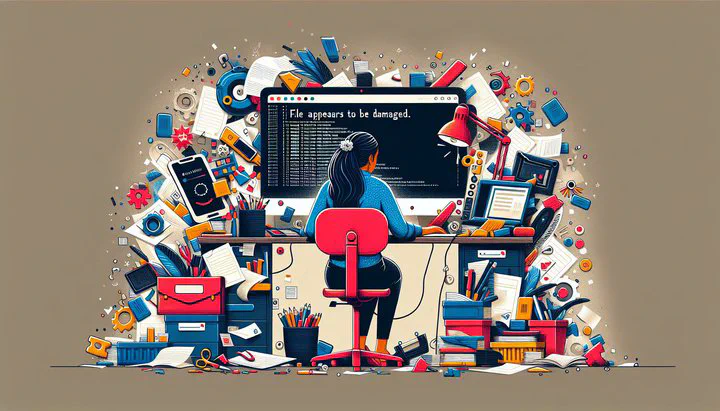Fixing File Appears to Be Damaged Error

Fixing the ‘File Appears to Be Damaged’ Error: A Designer’s Guide
Imagine you’re on a tight deadline, crafting a masterpiece in Adobe Creative Suite, and suddenly—BAM! A dreaded message pops up: “file appears to be damaged.” Panic sets in. But fear not; you’re not alone, and we’ve got the solutions you need to tackle this common issue and keep your creativity flowing.
Understanding the ‘File Appears to Be Damaged’ Error
Have you ever encountered a “file appears to be damaged” error while working on a project? This error message usually means there’s something wrong with the file you’re trying to open or save. It might happen because the file got corrupted during saving, leading to files corrupt with longer file name. Problems with file permissions can also trigger this error, suggesting your computer doesn’t think you have the right to access the file.
When this error pops up, it can really slow down your workflow. If you’re in the middle of designing something amazing, having to stop and deal with a damaged file can be a huge headache. It can mean lost time, lost work, and a lot of frustration. This is especially true for those of us who rely on Adobe software for our daily tasks. Understanding this error and its causes can help you get back to your creative projects faster and with less stress.
Common Scenarios Leading to File Damage
Encountering a “file appears to be damaged” error often leaves designers puzzled, wondering what went wrong. Let’s explore some common scenarios that can cause this issue, so you can avoid them in the future.
One frequent cause is files corrupt with longer file name. When file names are excessively long, it can confuse the software, leading to corruption. This usually happens because the software struggles to handle or process such lengthy names correctly. Keeping your file names short and clear not only helps avoid this error but also makes organizing and finding files easier.
Another situation that might lead to this error is when you’re trying to open a template and save it as a new file name. Templates are great for consistency, but sometimes saving them incorrectly can lead to errors. If you don’t save the template properly or the software doesn’t recognize the new file name, you might end up with a damaged file. Always ensure you’re following the right steps when saving templates to prevent such issues.
Lastly, you might face difficulties if you try to reopen the file it says I don’t have permission. This problem usually occurs due to issues with file permissions. It means your computer or software doesn’t think you have the right to access or modify the file. Checking and adjusting the file permissions can help you avoid running into this roadblock.
By understanding these scenarios, you’ll be better equipped to prevent the “file appears to be damaged” error from disrupting your design process. Stay tuned for practical solutions and tips to fix and avoid these errors!
Solutions to Fix and Prevent File Errors
Facing a “file appears to be damaged” error can be a real obstacle in your creative work. But don’t worry—there are ways to fix these issues and prevent them from happening again. Let’s dive into some practical solutions.
Firstly, if you’re dealing with file corruption, try renaming the file with a shorter name. Files corrupt with longer file name are a common problem, and shortening the name can sometimes resolve the issue. Make sure your file names are clear and concise to avoid confusion and potential errors. If the file is still not working, try opening it on a different device or software version. This can sometimes bypass the issue if it’s specific to your current setup.
When it comes to saving templates, ensure you’re following the correct steps. If you’re trying to open a template and save it as a new file name, always use the “Save As” option. This ensures that the template is saved as a separate file and reduces the chance of errors. Double-check that the file path and name are correct before saving. This simple step can save you a lot of headaches and help keep your workflow smooth.
For permission issues, where if you try to reopen the file it says I don’t have permission, you’ll need to adjust the file permissions. Right-click on the file, go to “Properties,” and then “Security” to check who has access. If your user account isn’t listed, add it and grant the necessary permissions. This will ensure you have the right to open, edit, or save the file without running into access problems.
By implementing these solutions, you can minimize disruptions and keep your creative process on track. Remember, a little prevention goes a long way. Regularly saving backups, keeping file names short, and managing permissions can help you avoid the dreaded “file appears to be damaged” error in the future.
Have you encountered this error before? Share your experiences in the comments below, and let’s help each other overcome these design hurdles! Stay creative and keep designing with confidence!